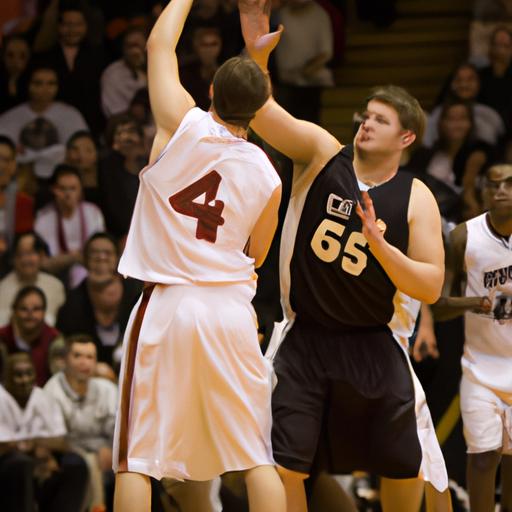How Many Fouls for Bonus in College Basketball: Understanding the Game-Changing Concept

Introduction
Have you ever wondered about the game-changing concept of bonus in college basketball? As avid fans of the sport, we often hear commentators mention this term, but what does it actually mean? In this article, we will delve into the intriguing world of college basketball fouls and explore the significance of the bonus. By the end, you’ll have a clear understanding of how many fouls are required to reach the bonus and why it plays a crucial role in the game.
Basketball is not just about scoring points or displaying incredible athleticism; it also involves strategic maneuvers that can turn the tide of a match. Fouls are an integral part of the game, and understanding their impact is essential for appreciating the sport in its entirety. When a player commits a foul, it not only affects individual players but can also influence the overall dynamics of a team.
However, fouls in college basketball go beyond just a penalty. They also serve as a gateway to an exciting phase known as the bonus. This concept adds another layer of strategy and excitement to the game, as teams try to reach the bonus to gain an advantage over their opponents. But how many fouls does it take to enter this coveted phase? Let’s dive deeper into the intricacies of the bonus in college basketball to find out.
Understanding Fouls in College Basketball
Fouls, the backbone of any basketball game, play a vital role in college basketball. They not only keep the game fair and safe but also have a significant impact on the flow and outcome of the match. To fully grasp the concept of the bonus, it’s crucial to understand the nature and significance of fouls in this sport.
Explanation of Fouls and Their Significance in the Game
Fouls occur when a player violates the rules of the game, resulting in penalties that can range from minor infractions to more severe transgressions. These violations can include actions such as pushing, holding, charging, or tripping an opponent. Each foul committed by a player contributes to their personal foul count.
Fouls play a crucial role in regulating the game and ensuring fairness. When a player commits a foul, the opposing team is awarded free throws or possession of the ball, depending on the type of foul and the situation. This not only penalizes the player who committed the foul but also provides an opportunity for the opposing team to score points or regain control of the game.
Different Types of Fouls and Their Consequences
In college basketball, various types of fouls exist, each with its own set of consequences. Here are the most common types of fouls:
Personal Fouls
Personal fouls are the most prevalent type in college basketball. These fouls occur when a player makes physical contact with an opponent that is deemed illegal. Depending on the severity of the foul, the player may receive a personal foul, resulting in free throws or the loss of possession.
Technical Fouls
Technical fouls are non-contact fouls that occur due to unsportsmanlike behavior. These can include actions such as excessive taunting, arguing with officials, or displaying disrespectful behavior. Technical fouls result in free throws for the opposing team and can also lead to ejection from the game.
Flagrant Fouls
Flagrant fouls are severe fouls that involve excessive contact or dangerous plays. These fouls can be either flagrant 1 or flagrant 2, with the latter being more severe. Flagrant fouls result in free throws for the opposing team and potential ejection of the player committing the foul.
Understanding the different types of fouls and their consequences is crucial in comprehending the intricacies of college basketball. It sets the foundation for comprehending the concept of bonus and its impact on the game. So, now that we have a solid grasp of fouls, let’s explore the intriguing world of the bonus in college basketball.
Introduction to Bonus in College Basketball
Definition and Purpose of Bonus in College Basketball
In the realm of college basketball, the bonus refers to a pivotal phase that occurs when a team accumulates a certain number of fouls within a specified period. Typically, when a team reaches a predetermined foul limit, they enter the bonus. This means that any subsequent fouls committed by the opposing team result in free throw opportunities for the fouled team, regardless of the type of foul committed.
The primary purpose of the bonus is to incentivize clean and disciplined gameplay. It serves as a penalty for teams that repeatedly commit fouls, while also providing an opportunity for the fouled team to gain an advantage. By allowing free throw attempts without any defensive interference, the bonus offers an equalizing factor, enabling teams to recoup lost points and potentially turn the tides of a game.
Importance of Reaching the Bonus
Reaching the bonus in college basketball is a highly sought-after achievement for teams. It not only provides an opportunity to score additional points but also alters the dynamics of the game. When a team enters the bonus, every foul committed by the opposing team leads to free throw attempts, which can significantly impact the overall score and momentum.
For the fouled team, the bonus presents a chance to capitalize on their opponents’ mistakes and narrow the point differential. Additionally, entering the bonus forces the opposing team to be more cautious with their defensive efforts, as any fouls committed can result in free points for their adversaries. This strategic shift adds an extra layer of intensity and excitement, as teams strategize to exploit the bonus and gain an advantage over their opponents.
The importance of reaching the bonus extends beyond individual games. Accumulating fouls and entering the bonus consistently throughout a season showcases a team’s ability to draw fouls and take advantage of the ensuing free throw opportunities. This can help teams establish a reputation for aggressive gameplay and make opponents more apprehensive while defending against them.
In the next section, we will explore the specific criteria that determine when a team enters the bonus in college basketball. Stay tuned to uncover the intricacies of this game-altering phase.
Determining the Bonus in College Basketball
Specific Number of Fouls Required to Reach Bonus
When it comes to determining the bonus in college basketball, there is a specific number of fouls that teams must accumulate before they can enter this advantageous phase of the game. Generally, in college basketball, a team reaches the bonus when their opponents commit a certain number of fouls within a specified period, typically per half. The exact number of fouls required may vary depending on the league or conference rules, but it commonly ranges from 7 to 10 fouls.
Reaching this foul threshold is a pivotal moment for teams, as it grants them an incredible opportunity to capitalize on their opponents’ mistakes. Once the bonus is reached, the fouled team is awarded free throw attempts, regardless of the type of foul committed. This can significantly impact the game’s dynamics, as it allows teams to score points without the clock running and potentially narrow the scoring gap or extend their lead.
Factors Affecting the Bonus Threshold
While the specific number of fouls for bonus remains relatively consistent, there are certain factors that may influence the bonus threshold in college basketball. One such factor is the level of play or the specific conference. Different conferences within college basketball may have slightly different rules regarding the bonus, which can affect the number of fouls required.
Additionally, game officials play a crucial role in determining the bonus threshold. Their judgments on fouls can vary based on their interpretation of the game and the level of physicality allowed. This subjective element can lead to slight variations in the number of fouls needed to reach the bonus, adding an element of unpredictability to the game.
Understanding the specific number of fouls required to reach the bonus and the factors that may influence the bonus threshold is vital for players, coaches, and fans alike. It allows them to strategize and adapt their gameplay accordingly, maximizing the advantages offered by the bonus phase and potentially turning the tide of the game in their favor.
Strategic Implications of Bonus in College Basketball
Advantages and Disadvantages of Reaching Bonus
Reaching the bonus in college basketball can drastically change the dynamics of a game and provide both advantages and disadvantages for the teams involved. Let’s explore some of the strategic implications associated with entering the bonus phase.
Advantages:
-
Free Throw Opportunities: When a team reaches the bonus, they are rewarded with free throw opportunities. This means that any subsequent fouls committed by the opposing team result in free throws for the team in bonus. This presents a golden opportunity to score points without any interruption from the clock. Capitalizing on these free throws can give a team a significant advantage in closing the gap or extending their lead.
-
Putting Pressure on Opponents: The bonus can put immense pressure on the opposing team’s defense. Knowing that any fouls committed could result in free throws for their opponents, teams in the bonus can strategically attack the basket, drawing fouls and forcing the opposition to make difficult decisions. This can lead to defensive lapses, foul trouble for key players, and an overall disruption in the opponent’s game plan.
Disadvantages:
-
Defensive Challenges: While reaching the bonus presents offensive advantages, it also poses defensive challenges. Teams in the bonus need to be cautious about committing fouls, as they risk sending their opponents to the free-throw line. This requires a delicate balance between applying defensive pressure and avoiding unnecessary fouls. One wrong move can give the opposing team easy scoring opportunities, potentially resulting in a shift in momentum.
-
Strategic Adjustments: The bonus can force teams to make strategic adjustments. For example, a team in the bonus may choose to play more aggressively, intentionally drawing fouls to gain free throw opportunities. On the other hand, the opposing team may adopt a more conservative defensive approach, focusing on preventing fouls and limiting the opponent’s free throw attempts. These strategic adjustments can significantly impact the flow and tempo of the game.
Strategies Employed by Teams to Exploit the Bonus
When teams reach the bonus, they employ various strategies to maximize its advantages and exploit their opponents’ weaknesses. Here are a few common strategies seen in college basketball:
1. Drawing Fouls:
Teams in the bonus often emphasize attacking the basket, aiming to draw fouls from their opponents. By driving to the hoop aggressively, players can force defenders to make contact, increasing the likelihood of free throw opportunities. This strategy not only provides chances to score easy points but can also put crucial players on the opposing team in foul trouble.
2. Utilizing Skilled Free Throw Shooters:
When in the bonus, teams prioritize getting the ball to their best free throw shooters. These players possess excellent free throw shooting skills and are more likely to convert their attempts. By capitalizing on these opportunities, teams can maximize their scoring potential and maintain their lead or mount a comeback.
3. Adjusting Defensive Approach:
Teams in the bonus need to be mindful of their defensive approach. Instead of risking unnecessary fouls, they may adopt a more disciplined defensive strategy. This can involve avoiding excessive physicality, focusing on solid positioning, and relying on team defense to minimize fouls while still contesting shots effectively.
By understanding the advantages, disadvantages, and strategic implications of reaching the bonus, teams can make informed decisions on how to exploit this phase of the game. Being able to effectively utilize the bonus can often be the difference between victory and defeat in college basketball.
Conclusion
In conclusion, understanding the concept of bonus in college basketball is crucial for fans and players alike. The bonus adds an extra layer of excitement and strategy to the game, as teams aim to reach the required number of fouls to enter this advantageous phase. By entering the bonus, teams not only gain the opportunity to score additional points from the free-throw line but also put their opponents at a disadvantage.
Throughout this article, we have explored the significance of fouls in college basketball and how they contribute to the formation of the bonus phase. We have learned that the specific number of fouls required to reach the bonus may vary depending on the rules and regulations of the league or tournament. It is important for players and coaches to be aware of these rules to strategically utilize the bonus to their advantage.
Reaching the bonus can be a game-changer, shifting the momentum in favor of the team that has earned it. It can provide an opportunity to close the point gap or even take the lead. Conversely, teams must also be cautious not to accumulate too many fouls, as this can result in their opponents entering the bonus and gaining the same advantages.
As fans, understanding the concept of bonus in college basketball allows us to appreciate the strategic decisions made by coaches, the skill of players in drawing fouls, and the impact it has on the overall flow of the game. So, the next time you’re watching a college basketball game, pay attention to the fouls and the bonus, and marvel at the intricacies that make this sport so captivating.
Remember, the bonus is not just a numerical threshold; it is a game-altering phase that can determine the outcome of a match. Embrace the excitement and strategy that the bonus brings to college basketball and enjoy the breathtaking moments it creates on the court.
Conclusion: So above is the How Many Fouls for Bonus in College Basketball: Understanding the Game-Changing Concept article. Hopefully with this article you can help you in life, always follow and read our good articles on the website: sports.canadianpharmaciesgen.com




